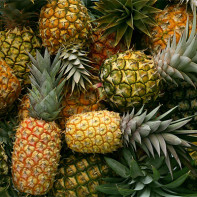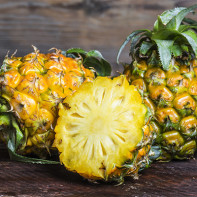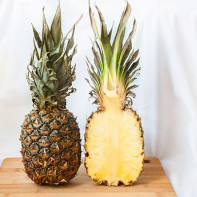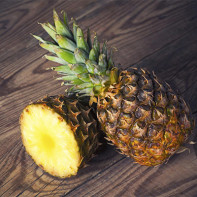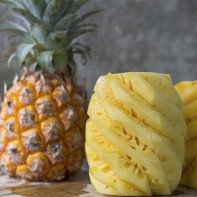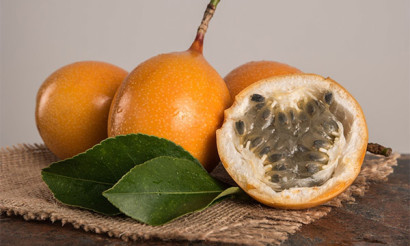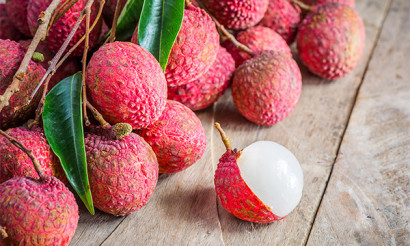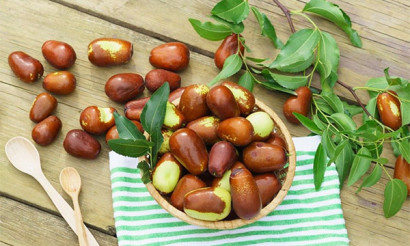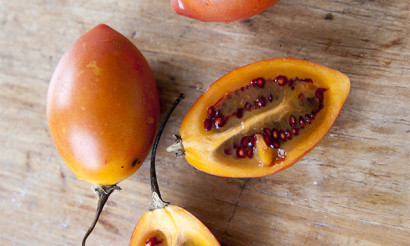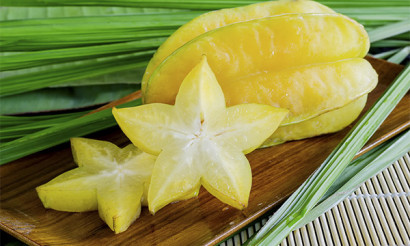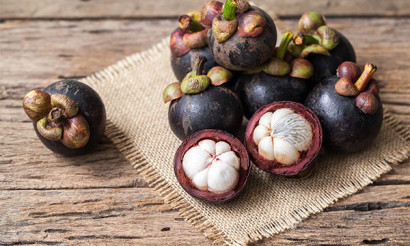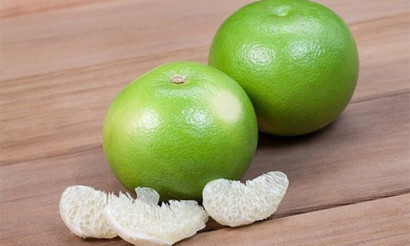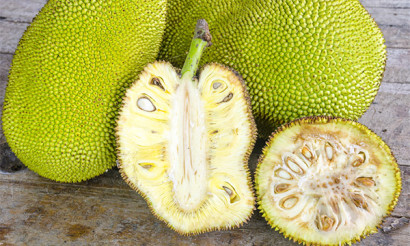Pineapple: useful properties and contraindications
Exotic tropical fruit is firmly entrenched in domestic stores and bazaars. This is not surprising, because the pineapple is very tasty, actively used in cooking, and most importantly - extremely useful. Now among all tropical fruits it is the pineapple that takes the third position by the volume of cultivation all over the world. Chefs appreciate it for its excellent properties to soften meat, it also gives dishes a sour-sweet taste and unique flavor, looks good when served. Women love pineapple not only for its refined taste qualities, but also for the opportunity to use it as a component for a diet, to become more beautiful and rejuvenated.
- What is pineapple and where does it grow
- Composition and calories
- What is the usefulness of pineapple
- General benefits
- For Women
- For Men
- In Pregnancy
- Breastfeeding
- For children
- Slimming
- Dried and dried pineapple: benefits and harms
- Pineapple Oil: Benefits and Application
- Candied Pineapple Benefits
- Is Canned Pineapple Useful?
- How to Canned Pineapple at Home
- Benefits and Harms of Pineapple Juice
- Pineapple in Medicine
- Diabetes
- For pancreatitis
- For Gastritis
- For Intestines
- For constipation
- For gout
- Pineapple in cosmetology
- Harm and Contraindications
- How to choose a ripe pineapple in a store
- How to store the pineapple correctly
- Can I freeze it?
- How to Peel a Pineapple at Home
- How to Eat Pineapple Properly
- How much can you eat per day?
- Can I Eat at Night and on an empty stomach?
- Can I Eat the Pineapple core?
- Why does the pineapple sting on the tongue and lips?
- Recipes for making with Pineapple
- Hawaiian canapés in 5 minutes
- Quesadilla with Pineapple and Chicken
- Delicious muffin with pineapple without baking
- Juice
- Candied pineapple
- Compote
- Jam
- Smoothie
- Salad
- Can I Give Pineapple to Animals
- Interesting Facts about Pineapple
What is the pineapple and where does it grow?
This tropical and extremely heat-loving fruit is native to an area between Peru and Brazil. Europeans first learned about the pineapple in the 16th century, and the first documented mention dates back to 1553. Notably, only one variety, Ananas comosus, is used as a food.
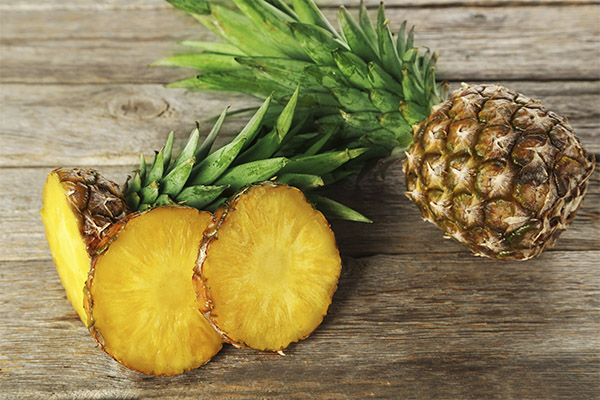
The perennial plant grows up to 60 cm and has a rich leaf base. The fruit can reach two kilograms. It consists of a hard scale-like rind and a soft yellow flesh, which is used for food. By the way, the local people used not only the juicy and tasty flesh, but also the long pointed leaves. They were used to weave mats, small household items and even decorative items such as table baskets or toys.
For a long time, the pineapple grew only in Brazil and Peru. Attempts to grow the fruit in warm European countries did not yield the desired result, despite the first harvest in 1658 and the construction of many court greenhouses. Much better results were obtained by cultivation in the Caribbean and Central America, especially in Costa Rica. But the real revolution came in the 19th century, when the pineapple was introduced to Asia with its own good-growing varieties. Today India, the Philippines and Thailand are the leading producers of the fruit worldwide.
Composition and calories
Pineapple is a very healthy fruit, while at the same time it has no calories at all. It is added to many, even the most stringent diets. Masses of useful substances well support the body. In 100 grams of pineapple contains the following substances:
- calories - 52;
- proteins - 0.3 g;
- fats - 0.1 g;
- carbohydrates - 11.8 g;
- dietary fiber - 1 g;
- organic acids - 1 g
- water - 85,5 g;
- ashes - 0.3 g.
The fruit contains useful saturated fatty acids, as well as omega-3 and omega-6. In 100 g of the product there are such vitamins, micro- and macronutrients:
- Vitamin C - 11 mg or 12.2% of the daily allowance;
- pyridoxine B6 - 0.1 mg or 5% of the daily requirement;
- Thiamine B1 - 0.06 mg or 4% of the daily allowance;
- Vitamin B5 - 0.16 mg;
- Alfa tocopherol E - 0.2 mg;
- Vitamin PP - 0.4 mg;
- Potassium 134 mg or 5.4% of the daily allowance;
- Silicon - 93 mg or just over 100% of the daily allowance;
- magnesium - 13 mg;
- calcium - 17 mg;
- phosphorus - 8 mg;
- chlorine 47 mg;
- Chromium, 10 mcg, or 20 percent of the daily allowance;
- Manganese - 0.8 mg or 40% of the daily allowance;
- Cobalt - 2.5 mcg or 25% of the daily allowance;
- Fluorine - 4.2 µg;
- Zinc - 0.12 mg;
- Molybdenum, 9.9 micrograms or 14% of the daily allowance;
- Copper - 113 micrograms or 11% of the daily allowance.
How is pineapple useful?
General benefits
Surprisingly useful tropical fruit can be safely recommended to all. It contains a special enzyme bromelain, which breaks down fats and helps to digest proteins. This is a great combination, which is suitable for those who lose weight and those who work out. Most of the fat is burned in the gastrointestinal tract, and the proteins get into the body and participate in building muscle mass.
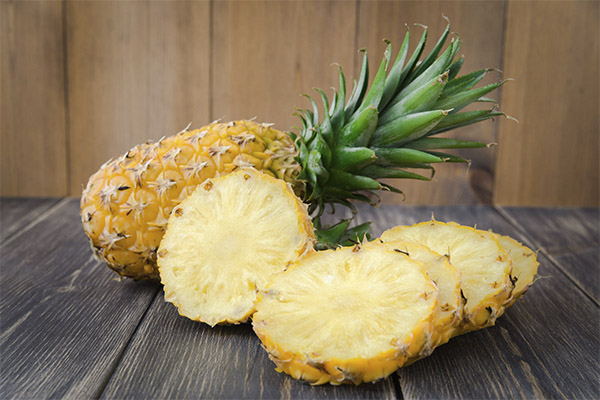
The complex of active substances in pineapple reduces blood viscosity, strengthens vascular walls, stimulates the digestive system and relieves symptoms of diseases of the pancreas.
Extracts, juices and pulp are actively used in cosmetology to soften the skin, saturate the subcutaneous layer with essential vitamins.
For women
Pineapple is the best helper in diets. It has practically no calories, but it saturates the body with useful substances and special enzyme bromelain. But don't think that you can eat sweets and fatty foods and then fix everything with a pineapple ring. Nutritionists include pineapple juice and pulp in almost all dietary recommendations; it's not a magic ingredient, but it's very beneficial.
Statistics say that women are more confirmed to have osteoporosis. Regular consumption of pineapple in any form without heat treatment will be an excellent prevention of this disease.
Pineapple is very useful for women's health, it reduces the intensity of menstrual pain, improves reproductive function and saturates the body with necessary substances during pregnancy.
For men
Even the Indians began to use pineapple in rituals dedicated to conception. Modern studies have confirmed that the consumption of the fruit already in 3 hours has a beneficial effect on the male reproductive system, increases sperm motility. The high content of manganese also improves male strength and stimulates libido.
The presence of special enzymes allows you to absorb 3.8% more protein from food. Pineapple is loved by all athletes for this reason, as it activates the growth of muscle mass and increases the effectiveness of training.
According to an Indian study, regular consumption of pineapple juice can reduce levels of low-density lipoproteins or bad cholesterol. Reducing blood viscosity gives additional protection against many cardiovascular problems.
In Pregnancy
Modern medicine recommends avoiding or minimizing the use of pineapple in the 1st trimester of pregnancy. This is due to the presence of active substances, which under certain conditions can be a factor for miscarriage in the early term. As the fetus develops, the risk is minimized. The only contraindication is allergies.
Pineapple allows you to saturate the body with all the necessary substances, especially during pregnancy, to normalize digestion and ease trips to the toilet.
When breastfeeding
The use of pineapple in the diet of a nursing mother will enrich the milk with all the necessary substances, strengthen the body, improve digestion. This means that more useful minerals and vitamins will be absorbed and then get into the milk.
However, there is a contraindication - pineapple is quite a strong allergen, which can provoke a reaction in the baby. Therefore, you should carefully and gradually introduce it into your diet, observing the behavior and condition of the child.
For kids
Tasty and useful tropical fruit is always loved by children. It can be given in any form - fresh or canned, juice or jam. A growing child's body needs many macronutrients and trace elements contained in pineapple.
In traditional countries where this fruit grows, it is given to children from 7-8 months. However, in our country it is better to postpone until 1.5-2 years. There is an old, Soviet instruction not to eat pineapple until 3 years. Previously, it was thought that the active ingredients can seriously harm even almost formed children's digestive system, but now European and American studies approve a gradual introduction to the diet of pineapple from 20 months.
For weight loss.
Pineapple is included in almost all diets. It is able to blunt the feeling of hunger, while activating digestion and breaking down fats due to bromelain. Using the pulp of the fruit and its juice, you can comfortably and controllably reduce up to 20% of daily caloric intake, significantly limit sweets and flour, while not risking to go off the diet.
Dried and dried pineapple: benefits and harms
Dried and dried fruits are unique due to the increased concentration of active substances and the special processes that take place inside during drying.
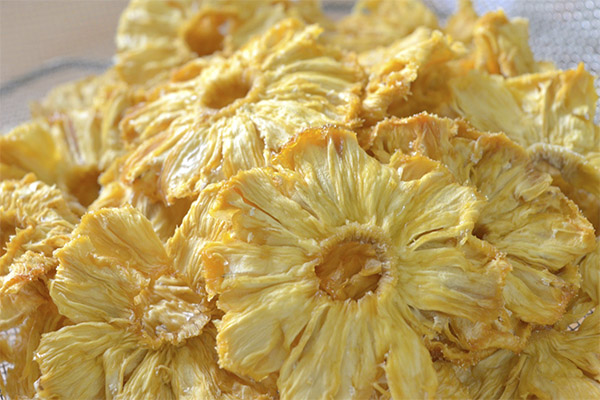
However, you need to be careful, it is quite easy to uncontrollably eat a couple of pieces of fruit for the equivalent of several kilos of fresh pineapple. This will lead to hypervitaminosis and a state of poisoning. Also, dried and dried fruit should be eaten with caution by diabetics and those with gastritis or ulcers.
Among the new possibilities of dried and dried pineapple should be mentioned the fight against smoking. This form allows an effective substitution therapy, just eat a few pieces and the desire to smoke will fall away for a while. A similar purpose of the fruit in diets - it helps to prevent a breakdown. When the desire to bite a sweet takes over - it is enough to eat a few pieces of dried or dried pineapple.
Pineapple oil: properties and uses
The process of making pineapple oil is very complex, it requires high-precision distillation, as well as a special carrier. Usually it is jojoba, coconut oil or almond oil. In the technological process the carrier specifically enriches the pineapple oil, so the preparations indicate on what basis the product is made.
It is a unique cosmetic and massage remedy, which has a mild warming effect, good antifungal and antimicrobial capabilities. It saturates the skin with useful vitamins and essential substances. The skin becomes firmer, the effect of visual rejuvenation is achieved.
You can treat your skin with pineapple oil after waxing or shaving. It can be used even on the most oily skin type and is absorbed very quickly, besides, there is no film effect.
Pineapple oil is used in massage practices as an aromatic and effective skin lubricant. The warming effect emphasizes the efforts of the masseur. At the same time, it is extremely useful for the skin, nourishing them with useful substances and vitamins.
The benefits of candied pineapple
The usefulness of candied fruits depends entirely on the type of raw material. They are made from fresh or canned pineapples. They slightly differ in the basic content of vitamins. It is more useful to eat candied pineapple from the fresh fruit.
Candied fruit gives a lot of energy, improves the mood. However, this dish can no longer be called completely dietary, because it is quite high in sugar. And this should be taken into account by people with diabetes.
Are canned pineapples useful?
On store shelves you can always find jars of canned pineapples. They are not only very tasty, flavorful and affordable, but also useful. However, the canning process loses about 20% of the useful substances and most of the vitamin C. This should be taken into account if you plan to use such pineapples as a fight against hypovitaminosis.
The rest of the useful properties are preserved. Canned pineapples are good for stimulating the digestive system due to the presence of the enzyme bromelain and other macro- and micronutrients. By the way, when choosing a really good canned should look not so much at the price, but at the format of cutting itself. At the factory, the most even and undamaged fruits are sorted for canned fruit with cutting in circles. Damaged fruit, with notches of rot or other differences from the standard, go to the line, where they are cut into cubes.
How to preserve a pineapple at home
You can preserve pineapples at home just like any other fruits and vegetables. The process is quite simple. You only need the most basic ingredients:
- sugar - 3 cups;
- one medium pineapple - about 500 g;
- water.
Peel the pineapple and chop it conveniently. Industrial canning goes similarly, but there is a sorting of the fruit. The best pineapples always go into slices and circles.
Shredded pineapple should be filled with sugar, place the container in the refrigerator overnight. After 10 hours, the fruit will let out enough juice for canning. Now you need to carry out heat treatment, bring the syrup with the pineapples to a boil, and then boil for 5 minutes. If foam appears in the process, it should be removed. The cooled pineapples in syrup can be transferred to sterilized containers and sealed hermetically for storage. Again, the homemade process is completely identical to the industrial process.
The benefits and harms of pineapple juice
Pineapple juice is a real vitamin squeeze, enriched with beneficial acids and substances. It is the juice recommended for mild seasickness, it alleviates motion sickness. It should also be drunk with colds, it has a lot of vitamin C and strengthens the overall immunity.
Soaked in pineapple juice compresses should be applied to the sore spot in case of sprains or arthritis attacks. It is the juice that is actively used by beauticians around the world. It saturates the skin, smoothes micro-wrinkles, reduces bags under the eyes, counteracts the emergence of dermatitis, acne and pimples.
Cooks use the juice to add a sour taste to dishes, adding it to sauces, marinades, jellies and gravies. It is a key ingredient in many liqueurs, cocktails, pastry creams and mousses.
Pineapple juice contains quite a few different organic acids. If you rinse your mouth or consume heavily, they can begin to destroy enamel, especially if you already have weak, damaged teeth. Also, people with peptic ulcer disease and complications of gastritis should refrain from drinking the juice.
Pineapple in medicine
The history of the use of pineapple for medicinal purposes dates back to pre-Columbian American times. It was used to treat various gastrointestinal problems and poisoning.
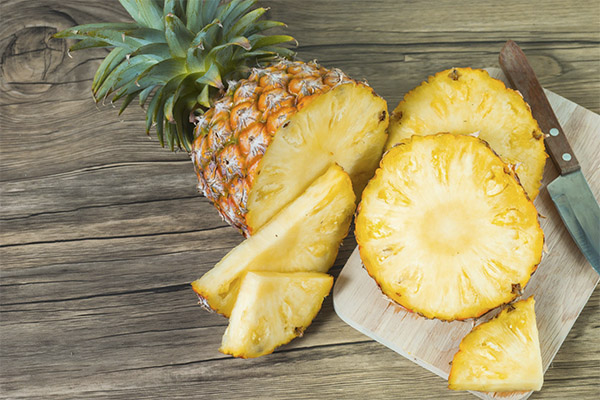
Modern medicine recommends using pineapple for diabetes, various intestinal disorders, chronic constipation, for the prevention of thrombosis and thrombophlebitis in risk groups as part of the complex therapy. Separately, we should highlight the enzyme bromelain - it breaks down fats, which makes it useful against the background of consuming fatty and heavy foods. This helps to relieve the effect of a heavy stomach and improve the condition.
For Diabetes.
Pineapple has an acceptable glycemic index of 66. The presence of a large amount of manganese makes the fruit especially useful for diabetics. Taking the juice can slightly reduce the swelling of the lower limbs and improve the overall condition. However, it should be understood that it is recommended to eat only fresh, dried or dried fruit. Canned in syrup slices and candied fruits have a large amount of sugar in their composition and are not suitable for diabetics.
For pancreatitis
Acute pancreatitis does not allow the consumption of any foods containing active acids. This will cause severe cramps and a sharp deterioration of the condition.
In chronic pancreatitis, it is generally allowed to eat pineapple, but according to certain rules. You can eat the fruit only after a dense meal, in no case can you consume juice or pulp on an empty stomach. It is allowed to add pineapple to foods fresh, stewed, roasted or boiled. Juice must be diluted with water or liquid with neutral acidity in the ratio of 1 to 1.
Gastritis
Gastritis requires an accurate diagnosis. Pineapple is extremely useful, but it increases the overall acidity, and if gastritis occurs on this basis, the deterioration is guaranteed.
After diagnosis, pineapples and other fruits can be added to the diet, but according to certain rules. Usually, you should never eat them on an empty stomach, but only with other foods or after a meal. Pineapple here acts as an additional enhancer for digestion.
For the intestines
Even the ancient peoples of Brazil and Peru used pineapple precisely as a universal cure for intestinal disorders. The active substances in pineapple improve the digestive system and stimulate intestinal peristalsis. The enzyme bromelain activates the breakdown of fats, increases the digestibility of useful substances and proteins. All this has the most beneficial effect on the overall work of the intestines.
For constipation
Pineapple has a pronounced but mild laxative effect. This refers specifically to the fruit itself, it can be eaten fresh, canned, dried or cooked. Pineapple acts very gently, but comprehensively. Fiber is necessary for a good and comfortable trip to the toilet. Stimulation of digestion gets rid of stagnant effects and activates peristalsis. All this leads to a serious softening and improvement of the quality of going to the toilet.
It is important to note that pineapple gives a good and statistically confirmed effect exactly in counteracting chronic constipation, because it removes the cause of their occurrence.
For gout
In order to alleviate gout, a strict diet is necessary. Pineapple is one of those foods that are definitely prescribed for this ailment. It can be eaten in any form. On its own it does not interact with gout, but has a restorative effect.
However, there are also cocktails that relieve the condition. For example, you need to grind the pulp of a medium-sized pineapple in a blender, pour a glass of cherry juice, preferably freshly squeezed, add a teaspoon of turmeric, two teaspoons of ground ginger and honey. Mix everything into a homogeneous mass and pour it into a glass jar. The cocktail should be infused in the refrigerator for a week. After using half a glass every day.
Pineapple in cosmetology
Ingredients in the form of pulp, juice, oil or extracts are included in many professional cosmetic creams, masks and shampoos. The main tasks that pineapple solves when interacting with skin, nails or hair are as follows:
- gentle cleansing;
- care of oily skin and hair;
- saturation with vitamins;
- exfoliation.
Nowadays the tightening face masks are popular. They are very simple to prepare, you need to take a tablespoon with a handful of pineapple pulp, one egg white and a teaspoon of honey. The pulp of the fruit should be finely ground, using a grater or blender. If the honey is too hard, you should melt it in a water bath until it has a flowing consistency. Mix all the ingredients until homogeneous and apply to the face, avoiding the area around the eyes and lips. Time of action is 15 minutes, then rinse off with lukewarm water.
People with oily skin are recommended to simply wipe their face with a piece of pineapple once every two days. This helps to normalize the condition of the skin, prevent the occurrence of acne.
To soften the cuticle is good to use warm baths with pineapple juice, the solution should have a 35% concentration. The softening effect will come in 10 minutes. It will also saturate the nail plates and the subnail layer with necessary vitamins.
Pineapple is in many shampoos and professional multi-ingredient hair masks. However, there is an effective and simple combination that allows you to give your hair silky, shiny and full of life to the ends. Pineapples and bananas in the ratio of 1,5 to 1 are used. Whip the products in a blender and apply them from hair roots to the tips. Time of action of the mask - 30 minutes, then wash off the remains with warm water.
Harms and contraindications
Fresh or canned pineapple will not cause any harm to a healthy person. The concentration of toxic substances is many times greater than the actual amount consumed. If you do not eat 4 kg of fruit at a time, there will be no harm.
Somewhat different situation with dried and dried pineapples. They have a greater concentration of active substances, and it is easier to eat a lot of them. However, if you stick to the norm of 300 grams of dried product at a single daily consumption, there will be no problems. Candied fruits and jam are harmful because of the sugar.
A clear contraindication for use is allergies. Everyone can have it, especially in our country, where this tropical fruit could not appear naturally. Therefore, the first acquaintance should begin with a few slices or sips of juice.
Do not consume pineapple with peptic ulcer disease, acute pancreatitis, undiagnosed gastritis. This can lead to a worsening of the condition. Modern medics do not recommend eating pineapple in the first trimester of pregnancy, although there are no statistics on the increase in the number of miscarriages against the background of the consumption of products from this fruit.
How to choose a ripe pineapple in the store
Pineapples come to our country thousands of kilometers away by ship. Therefore, inevitably there are defects, some fruits overripe, some - remain unripe and begin to rot. The fruit is expensive, and you can often find low-quality specimens, even outright spoiled ones, on the shelves. That is why it is important to learn how to choose a good and healthy pineapple, it is not difficult. There are only four main points, on which you should pay attention.
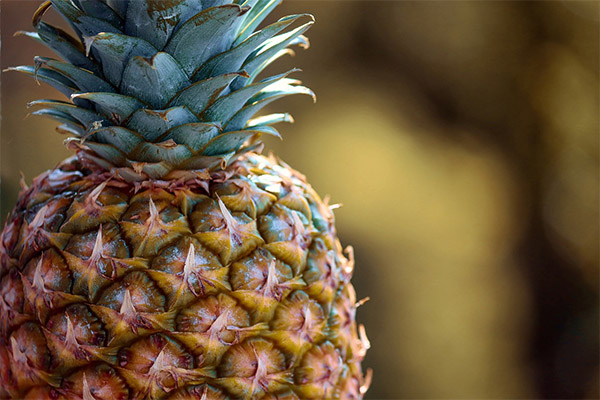
- Smell. The ripe pineapple has a soft and delicate smell, which is almost imperceptible. If there is no smell at all, it means it is not ripe. A pungent, noisy odor is a clear signal that the fruit is overripe or has already gone bad.
- The haulm. Juicy tops are a sign of a ripe pineapple. Stale leaves that are starting to turn yellow are a sign of improper storage or the beginning of spoilage. If an individual leaf is too tough to peel, it means the pineapple is green.
- Crust. You need to feel the peel; ripe fruits have a slightly soft and firm crust. Unripe pineapple has a hard and unyielding peel. If there are dark spots on the peel, it means it has already gone bad. Incidentally, a green peel does not mean the pineapple has not ripened yet, but may be a feature of the variety.
- The condition of the pulp. The quality of the pulp can be checked on the counter (by analogy with watermelon). It is necessary to pat a little on the crust with the palm of your hand. If the sound is deaf - then everything is fine, the pulp is in the right condition. An empty sound is a sign of an overripe fruit.
How to store a pineapple properly
There can be problems with storing a tropical fruit. A whole, unpeeled pineapple retains its full flavor best at room temperature around 20 degrees. Depending on the ripeness, however, it will keep in proper condition from 2 days to a week.
Industrial storage is done at a fixed temperature of 7 degrees, good ventilation and low humidity.
Refrigerator prolongs storage up to two to three weeks. It is only necessary to wrap the fruit in a paper napkin with holes for breathing. However, it will become more watery and taste slightly different at a stable low temperature.
The cut fruit can only be stored in the refrigerator for no more than 72 hours. The only way to make it last longer is to preserve it, make it into jam or candied fruit, freeze it, or dry it.
Can I freeze?
The whole pineapple cannot be frozen but you can preserve this aromatic, healthy and tasty fruit for a long time. You need to peel the fruit and chop it into bite-sized pieces. It is easiest to store cubes, but you can make half rings or rings. They should be put in a bag and evacuate the air with a vacuum cleaner, and then put it in the freezer.
You can make do with simply sterilized and hermetically sealed containers, but this is less convenient. Frozen pineapple chunks can be stored for up to three months. They retain their flavor and aroma well, with almost no loss of vitamin C.
How to peel a pineapple at home
It may seem difficult to peel a pineapple, because you don't want to lose the pulp by removing the dense skin. However, the restaurant level of peeling is achievable even at home, and it really isn't difficult.
The fruit should be placed horizontally, cut off the top and bottom. Next, place the pineapple and carefully cut off the skin, taking as little pulp as possible. There will remain inedible eyes, which must be removed. The structure of the fruit is such that the eyes line up in parallel diagonal rows. For this reason, with two 45-degree cuts, you can remove a whole row at once and save a lot of useful fruit pulp.
Next, you should decide on the type of slicing. The easiest way to cut the fruit into cubes or slices. It is enough to cut it in two, and then each part in two more. This will remove the tough cores with an ordinary knife, just cutting them at an angle. Next, chop in the usual way.
Cutting into slices is more difficult precisely because of the core. They need to be sliced at once portion thickness. Then with a vertically placed knife carefully cut out the core, ideally you should get a perfect fruit bagel. In a restaurant, they use a special mold for cutting out the core, where the circle comes out just perfect in a minimum of time. It can be bought in specialized stores.
How to Eat Pineapple Properly
The tropical fruit must be properly peeled. The peel does not go in food, but the core can be used in a limited way in juicing. The rest of the fruit is edible and suitable for various types of processing.
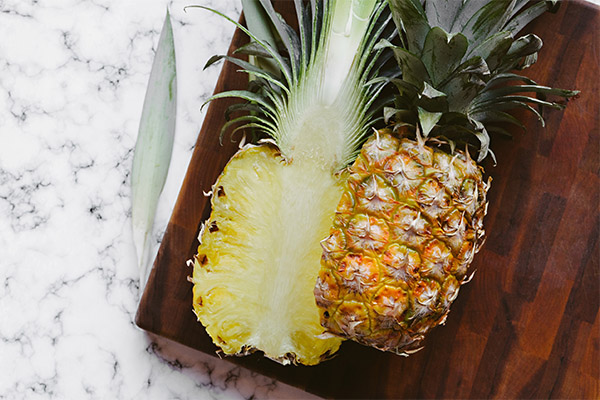
- Fresh pineapple can be cut into pieces and eaten on its own or as part of another dish, such as ice cream, cereal, or a salad.
- The juice can be drunk cold, warm, or hot. It is also added to marinades, sauces, creamy desserts, ice cream, and smoothies.
- Frozen fruit must be thawed completely before consumption. Pineapples can be heat-treated, fried, stewed, baked, and boiled; in the process, they soften significantly.
How much can be eaten per day.
Pineapple can be called a harmless product. However, the excessive constant consumption can increase the acidity of the stomach, lead to hypervitaminosis and an overabundance of some macro and micronutrients that will begin to accumulate in the body.
A healthy adult should eat no more than half a pineapple a day or drink about a glass of juice in conditions of daily consumption. However, even a significant single increase in the diet (up to 2 fruits per day) will not lead to serious consequences, although short-term discomfort may occur. Of course, a healthy dose is about 200 g of pineapple a day.
Is it possible to eat at night and on an empty stomach?
A healthy person to eat pineapple at night and on an empty stomach is even useful, especially for weight loss. The enzyme bromelain will work effectively, melting the remaining fat. This will lead to a better figure and weight loss in a short period of time.
However, there are also contraindications. It is quite stressful for the body, as the empty digestive system is stimulated. Prolonged consumption of pineapples or juice on an empty stomach before bedtime can lead to gastritis and heartburn.
If certain conditions, such as gastritis or pancreatitis, are diagnosed, pineapple can only be eaten with food or half an hour after a meal.
Can the core of a pineapple be eaten
There are no harmful chemical or poisonous substances in the pineapple core. It is removed because of its coarse fibrous structure, as it is quite difficult to chew. Moreover, poorly chewed hard pulp can damage the walls of the esophagus. However, in the industry, the juice is often squeezed whole along with the core. It can also be consumed after being chopped in a blender.
By the way, it is in the pineapple core that the greatest concentration of the enzyme bromelain. Therefore, nutritionists and athletic trainers may advise to squeeze juice from it or consume it in a chopped form.
Why pineapple makes your tongue and lips sting
The composition of the fruit includes quite active organic acids and the enzyme bromelain. Therefore, in areas with particularly delicate skin and mucous membranes there is a slight discomfort. This does not carry any harm to the body and is a completely normal reaction to the active components of pineapple.
However, a slight tingling sensation should not be confused with a burning sensation in the mouth. This is a more serious problem and usually occurs if the pineapple is unripe or already spoiled. It contains slightly different substances and actively irritates the tongue and mucous membranes. A thorough rinse of the mouth and throat with warm water will alleviate the condition.
Recipes for making with pineapple
Pineapple is an extremely sought-after fruit in any kitchen. It is versatile and applicable almost everywhere.
Hawaiian canapés in 5 minutes
These are perfect appetizers for any occasion, especially when time is running out and guests are approaching the house. These are tasty viands that can be assembled from whatever you can find in the fridge. However, the key will be the addition of fresh or canned pineapple. It will set the right flavor, aroma and a touch of exoticism. For a heavy canapé, you will need the following components:
- Slices of ham, bologna or other prepared meat;
- pineapple slices;
- cheese.
You can additionally use pickled onions or garlic, herbs, any spices. Cut the pineapple in half rings, put a similar piece of cheese on it and wrap the ham - the canapé is ready. It only takes a couple of minutes.
Light canapés call for any available fruit or berries, where again pineapple will set the desired flavor. Ingredients:
- Slices of fresh or canned pineapple;
- Strawberries or any large and sweet berry;
- pear or soft apple;
- A mango, orange, or banana.
All you need to do is chop the fruit and string it on skewers. This combination will give the best balance of flavors and aromas. It can be accompanied by honey, chocolate paste or sour cream as a sauce.
The Hawaiian sandwich is ready in 5 minutes and has a great look and flavor. The complex combination of flavors makes it a real treat. To prepare it, you will need the following products:
- white bread;
- fresh tomato;
- hard cheese;
- Canned pineapple in rings.
Put the slices of bread immediately in the pan to get a crust. Cut the tomato and cheese into slices. On the bread with a crispy crust, place the tomato, followed by the pineapple and a slice of cheese. Bake everything in the microwave for 20-30 seconds until the cheese is melted.
Quesadilla with pineapple and chicken
This is a great dish that can be made in half an hour. Pineapple here not only sets the flavor and taste, but also softens the chicken, making the filling really tender. To prepare it, you need the following ingredients:
- tortilla;
- one chicken breast;
- 200 g of pineapple;
- Some hard cheese;
- butter - 40 gr;
- ground black pepper;
- salt;
- dill, parsley, basil or coriander.
You can use any herbs, also add more spices or cheese. Most stores today sell pretty good tortillas, so there is no need to bake them yourself.
Place finely shredded chicken fillets in the pan. While it is roasting, you can lightly chop pineapple slices and after 5 minutes add them to the chicken. The juices of the fruit will soften the meat and make it very tender. When ready, clean the skillet, put butter in it and bring the tortilla to a golden color on both sides. Now you can assemble the quesadilla - on a tortilla put the fried pineapple, chicken, add herbs and peppers, and top with cheese and cover with another tortilla. Put the assembled tortillas back on the griddle for literally 2-3 minutes to allow the cheese to melt. After that, you can serve.
Delicious muffin with pineapple without baking
Baking discourages many people because of the need to fiddle with the dough. This recipe can be implemented with a minimum of effort without baking. It turns out delicious and healthy. You will need the following products:
- cottage cheese - 400 g;
- can of canned pineapple;
- condensed milk;
- Gelatin - 20 g.
It is better to take cottage cheese with a fixed fat content. First you need to prepare the base for the jelly, pour a glass of cold boiled water into a saucepan and dissolve the gelatin in it, bringing everything to a low heat. Mix the cottage cheese, condensed milk and chopped pineapple until homogeneous. Pour the cooled gelatin solution into the base and mix everything. Fill the mold or plate with the future cupcake and put it in the fridge for 5 hours. After that you can serve the elastic, beautiful, very curd sweet muffin with a pronounced pineapple flavour to the table.
Juice
Pineapple juice is a real concentrate of vitamins and nutrients. However, it is important that it be freshly squeezed. Store products are significantly poorer in terms of exactly the usefulness for the body.
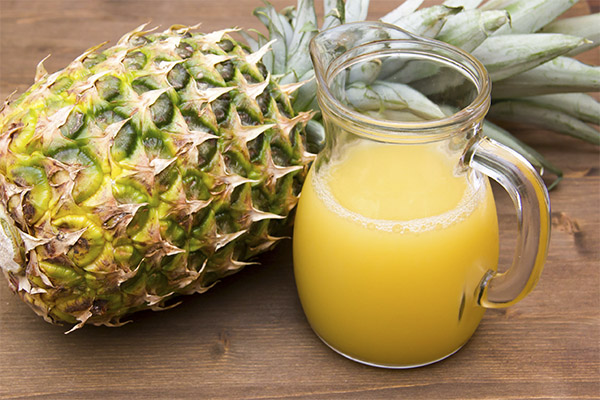
In order to make it, you should peel the fruit and cut it. The core can not be cut out, there are more useful enzymes that break down fats. The best and fastest way is to use a blender. It is acceptable to sweeten the mixture with one or two teaspoons. Then grind the mass thoroughly, this will take 2-3 minutes of work.
If you need juice with pulp, it is enough to pass it through a coarse sieve, filtering out very large fractions. The clear juice must be filtered using folded in 7-8 layers of gauze. Serve the drink with an ice cube.
Candied Pineapple
Candied pineapple is a true delicacy, they are long and not easy to prepare, but the result will justify every minute spent. The preparation will involve the following components:
- one medium pineapple;
- sugar - 800 grams.
In addition, you can use food coloring to give the fruit different bright colors. The pineapple itself should be cut into small cubes, half rings or slices.
Sugar and water should be mixed in a saucepan and bring everything to a boil. Then add the prepared pieces of pineapple. Cook on low heat for 10 minutes. Remove the pot from the heat and let it stand for about 3 hours. Stir and bring back to the boil, simmer for 10 minutes. The procedure should be repeated 4-5 times, the fruit should become transparent and soaked in sugar. If rings are used, they should be stirred very carefully. At 2-3 boiling, the pineapple will become quite tender, so you can accidentally ruin the appearance of the slices.
After the end of the process, you need to put the mass in a colander and let the syrup drain. This is a long process, so you can leave the pineapples for 2-3 hours. The final stage of preparation will require drying the fruit, on parchment you need to lay the slices or cubes in a row and send it to the oven at 50 degrees for 6 hours. Pineapple candied fruits are ready, you can serve them to the table.
Compote
Useful, very tasty and fragrant pineapple compote is not difficult to prepare. You will need the following components:
- one pineapple;
- sugar - 80 grams;
- water - 500 ml.
Peel the pineapple, remove the core, and portion it out. It is better to be guided by a teaspoon so that a piece of fruit can easily fit in it, but you can also cut coarsely.
Boil water, add sugar and stir everything until dissolved. Then add the pineapple chunks and boil for another 15 minutes after boiling. An important point: the compote must not only cool down, but also infuse. The most intense flavor will come in 2-3 hours after the end of cooking. You can serve it with or without pulp.
Jam
It is best to combine pineapple with something distinctly sour when making jam. A great choice is lemon or tangerine, and you can use just their juice or pulp as well. For a classic recipe for jam you will need the following components:
- pineapple - 1 kg of pulp;
- 400 grams of sugar;
- Half a lemon.
Instead of lemon, you can use 2-3 tangerines. Initially, you should cut a peeled pineapple without a core into small cubes. It takes about half an hour for the pulp to juice.
Now the resulting mass should be transferred to a saucepan and pour a liter of water. After boiling, boil for about 15 minutes, stirring occasionally. At this stage, you can add the juice of a lemon or tangerine. After reaching the desired consistency, remove from the stove, cool and can be placed in sterilized jars for storage.
Smoothie
This is an extremely healthy drink that can be enriched with grapefruit, ginger, banana, nonfat yogurt. Exceptionally pineapple smoothie is extremely simple to make, you need to chop the peeled fruit for the blender, not even removing the core, thoroughly whip everything to a smooth puree and put on the table.
The most winning combinations for a pineapple smoothie are as follows:
- 200 g pineapple;
- one glass of white yogurt;
- one banana;
- A pinch of vanilla.
Grind the fruit into a puree with a blender, then add the vanillin, yogurt and whip again.
This is a refreshing, very mild and delicious drink, the best way to start the day.
Products:
- 100 g pineapple;
- The pulp of half a grapefruit;
- One small fresh cucumber;
- A few centimeters of ginger root;
- half a glass of water.
Peel the fruit and vegetables, grate the ginger root, put everything in a blender, add water, mix into a puree. You get a slightly unusual taste, but very refreshing smoothie, which will quench thirst and dull hunger.
Salad
Pineapple is a key ingredient in many salads with meat and vegetables. It is most optimal to combine the fruit with mayonnaise sauce and chicken. Together it turns out a complex and very pleasant taste. For cooking, you will need the following components:
- chicken fillet - 1 pc;
- canned corn - 300 gr;
- pineapple - 400 gr;
- One small onion (red or lettuce);
- garlic clove;
- mayonnaise.
You can add some hard cheese with bright flavor, fried mushrooms, any spices and herbs. Initially, the fillets must be fried. Allow it whole, you can chop it beforehand, so it will be ready faster. Add shredded onion to the meat 3-5 minutes before cooking. It is necessary to achieve a slight softening of spice and some transparency. After cooking, leave meat and onions to cool in the fridge.
Pineapples cut into portions, add canned corn, cooled meat and onion, as well as garlic with a crusher or grater. Mix everything and dress with mayonnaise. An exquisite salad with a tantalizing look and complex, but very pleasant taste, is ready.
Can I Give Pineapple to Animals
Cats and dogs can get the treat in limited quantities. Even a pet parrot will be happy with such a treat. The main thing is not to give too much, even if the pet really asks for another piece.
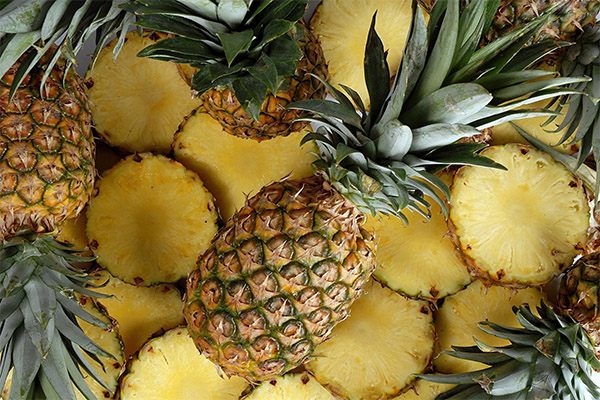
Vitamins B6, magnesium and iron in the fruit are essential for many animals. Bromelain in cats and dogs is involved in the digestion of proteins, helping to digest food. Therefore a piece of tasty fruit is best given 15-20 minutes after a meal.
Excessive systematic feeding of pineapple will lead to a severe digestive disorder in the animal, vomiting, diarrhea will begin, and the natural system of breaking down fats will be disrupted for a long time. Also the toxic dose for a cat or dog is quite small, the symptoms of poisoning will appear already after the consumption of 80-100 grams of fruit.
Interesting facts about pineapple
- A perennial plant of the bromeliad family bears fruit only once in its life. It is an extremely labor-intensive crop, if it had not taken root in Asia, today the pineapple would remain a delicacy of kings (like in the 16th century). It takes 12-16 months from planting to flowering. For another 3-5 months, the fruit matures, after which the plant dies off, producing new shoots that start the cycle all over again.
- Remarkably, botanically speaking, the pineapple is not a fruit or even an ordinary berry. The cob is represented by a separate inflorescence fused together. Therefore, it is several dozen berries that form a single fruit.
- Almost all tropical fruits are capable of ripening already plucked, but not the pineapple. If the fruit is picked green, it will remain unripe even when it begins to rot.
- The pre-Columbian Indians of America valued the leaves of the fruit. The tough, hard-wearing fibers were used to weave mats, items of clothing and decor, various toys and everyday objects. Today, amazingly strong pineapple fibers are also used in production, for example, a special fabric Pinatex is patented and is being produced. It is used to make handbags, purses, shoes, various wear-resistant covers.
«Important: All information on this site is provided for informational purposes only. purposes. Consult with your health care professional before applying any recommendations. specialist before using the recommendations. Neither the editors nor the authors shall be liable for any possible harm caused by materials."

